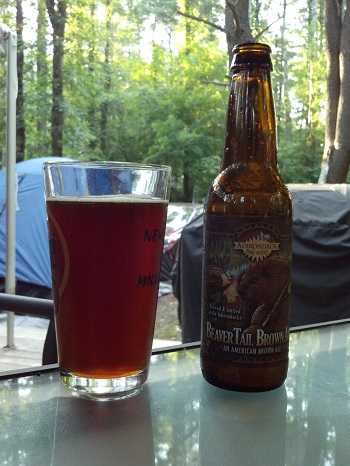Engineering Degree

Brewery and Country of Origin: Adirondack Pub & Brewery of 33 Canada Street, Lake George, NY 12845, USA
Date Reviewed: 8-20-13
If the lion was the popular kid, the greyhound was the track athlete, and the owl was the teacher, the Castor, or Beaver, would easily be the science dork. Globally, there are only two species of beaver, one native to North America, and the other originating in Eurasia. But what makes the beaver quite an intelligent and special creature is, well... quite a lot actually. If you didn't know, beavers are the second largest rodents on earth, and tremendous swimmers, thanks to their famously broad, scaly tail. They are also obviously known for their ability to build dams for use as homes, protection from larger & scary animals, and as food caches during the winter. No, beavers don't actually eat hardwood, they just chomp it with their large front teeth to cut down trees and branches. They do, however, munch on inner bark and soft twigs, especially during the winter months, when they spend more time in the dam. Their favorite food is the water lily, and like most rodents, they are herbivores. These dams can be quite disruptive to the local environment, creating floods which can wash away nearby railroads and highways. The act of cutting down trees can also destroy other species' habitats, including that of endangered birds and other smaller animals. And despite living in generally colder climates, beavers do not hibernate and conduct most of their activity during the night. The beaver played an important role in the development of the Northeast United States, as one of the main subject of the 16-17th century North American Fur Trade. Beaver pelts were traded by Native Americans to Europe (notably The UK, and France) in exchange for more modern conveniences. The pelts were then turned into hats which provided explorers a good source of heat. This same practice was adopted by the Coureur des Bois (runners of the woods) - French-Canadian hunters who took advantage of the economic benefits of beaver pelts. The trade was so great that the North American Beaver became endangered, with their population dwindling from more than 60 million to an estimated 6-12 million, of which many still claim residency in what is now called the Adirondacks, home of the Adirondack Brewery. The brewery pays homage to this busy creature who helped shape what is now known as the State of New York, especially the Adirondacks region. This Brown Ale's shade imitates the color of the beaver's famous pelt, and its heartiness is a tribute to the beaver's tenacity, especially during the Beaver Wars: a 70 year series of conflicts between the English/Dutch supported Iroquois, and the French backed natives toward the west and north. Like today's patent battles of Apple and Samsung, these two groups literally fought to expand land share in order to monopolize the fur trade, essentially driving the beaver to near extinction. Fortunately, in 1903, NY legislature banned beaver hunting, and ended up with a plan to restock the beaver population. Though they released less than 50 beavers into the wild, the population grew exponentially, and today, more than 60,000 inhabit the Adirondacks alone.
Date Sampled: 7-19-13 At: Puffin's Wilderness Refuge, Stab City, Blackthorne Resort, 348 Sunside Road, East Durham, NY, USA
Beer Style: American Brown Ale
Alcohol by Volume: 5.60%
Serving Type: 12 oz Bottle, 16 oz Tumbler Glass
Rating: 3.09
 Beaver Tail Brown Ale
Beaver Tail Brown Ale




